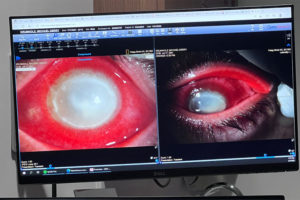Mike Krumholz says he just took a nap. He didn’t think to take out his contacts. Now he’s taken to social media to spread the importance of proper contact care.
Krumholz developed acanthamoeba keratitis in his right eye thanks to a fateful 40-minute nap on December 19.
The 21-year-old college student from Florida says he woke from his nap with an irritation in his eye. He still was experiencing irritation the next day.
“I told my parents ‘I gotta go to the eye doctor, something isn’t right,’” said Krumholz in an interview with the British tabloid The Daily Star.
“I thought I had pink eye or something and (the doctor) took a picture of the back of my eye after dilating. And he was like, something is not right.”
According to Krumholz, his optometrist thought he might have herpes and referred him to an eye specialist.
Advertisement
Krumholz says he eventually met with five ophthalmologists and two cornea specialists. He says each diagnosed him with herpes simplex virus type 1 (HSV-1). His treatments included antibiotics and steroids.
But nothing worked. His symptoms only got worse. His pain only increased

Source: Mike Krumholz’s TikTok account @mikekrumholz13
Krumholz says it took more than a month before he was given a correct diagnosis. On January 21st, the Bascom Palmer Eye institute at the University of Miami informed him he had acanthamoeba keratitis.
From the Centers for Disease Control website:
“Acanthamoeba keratitis is a rare but serious infection of the eye that can result in permanent visual impairment or blindness. This infection is caused by a microscopic, free-living ameba (single-celled living organism) called Acanthamoeba.”
Advertisement
Acanthamoeba is a common bacteria found in most water sources, according to the American Optometric Association.
While infection is rare, contact wearers are at higher risk. Eyecare professionals warn against wearing contacts in the shower or while swimming as the bacteria can slip between the contact lens and the cornea. Sleeping in contacts that have not been properly cared for allows the bacteria an opportunity to feaster.
Because infection is so rare, the American Academy of Opthalmology says, “Diagnosis of Acanthamoeba keratitis is difficult and often delayed.”
Advertisement
According to an article in The New York Post, “Krumholz underwent a procedure called photodynamic therapy, where the white of the eye was put over the pupil in order to fight off the parasite.”
However, the bacteria had feasted enough on his cornea to render recovery a dim prospect. Krumholz says doctors told him a transplant might be necessary.
This past weekend, Krumholz posted an update on his TikTok account: “Cornea transplant today went well 🤞🏼 #acanthamoebakeratitis journey continues.”